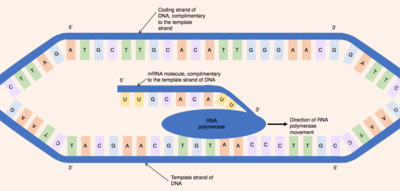What Is A Template Strand

Position of the template and coding strands during transcription.
When referring to Deoxyribonucleic acid transcription, the coding strand (or informational strand [one] [2]) is the DNA strand whose base sequence is identical to the base sequence of the RNA transcript produced (although with thymine replaced by uracil). It is this strand which contains codons, while the not-coding strand contains anticodons. During transcription, RNA Pol Ii binds to the not-coding template strand, reads the anti-codons, and transcribes their sequence to synthesize an RNA transcript with complementary bases.
By convention, the coding strand is the strand used when displaying a DNA sequence. Information technology is presented in the five' to three' direction.
Wherever a gene exists on a Deoxyribonucleic acid molecule, one strand is the coding strand (or sense strand), and the other is the noncoding strand (likewise called the antisense strand,[iii] anticoding strand, template strand or transcribed strand).
Strands in transcription chimera [edit]
During transcription, RNA polymerase unwinds a short section of the DNA double helix near the kickoff of the factor (the transcription start site). This unwound section is known every bit the transcription bubble. The RNA polymerase, and with it the transcription bubble, travels along the noncoding strand in the reverse, iii' to 5', direction, besides every bit polymerizing a newly synthesized strand in 5' to iii' or downstream direction. The Deoxyribonucleic acid double helix is rewound by RNA polymerase at the rear of the transcription bubble.[iii] Like how ii next zippers work, when pulled together, they unzip and rezip as they proceed in a detail direction. Various factors tin can cause double-stranded Dna to pause; thus, reorder genes or cause jail cell death.[4]
RNA-Dna hybrid [edit]
Where the helix is unwound, the coding strand consists of unpaired bases, while the template strand consists of an RNA:DNA composite, followed past a number of unpaired bases at the rear. This hybrid consists of the most recently added nucleotides of the RNA transcript, complementary base-paired to the template strand. The number of base-pairs in the hybrid is under investigation, but it has been suggested that the hybrid is formed from the last 10 nucleotides added.[5]
See also [edit]
- Sense strand
- Sense (molecular biology)
References [edit]
- ^ "28.four: Transcription of DNA". Chemistry LibreTexts. 2015-08-26. Retrieved 2021-09-06 .
- ^ STOKER, H. STEPHEN (2013). Full general, Organic, and Biological Chemistry. Cengage Learning. p. 816.
- ^ a b Lewin, Benjamin (2008). Genes Nine. Oxford University Press. p. 129, 235. ISBN978-0-7637-4063-4.
- ^ Dianatpour A, Ghafouri-Fard Southward (2017). "The Office of Long Non Coding RNAs in the Repair of DNA Double Strand Breaks". International Journal of Molecular and Cellular Medicine. vi (ane): 1–12. PMC5568187. PMID 28868264.
- ^ Griffiths 2005, pp. 259–265
Works cited [edit]
- Griffiths, A.J.F.; et al. (2005). Introduction to Genetic Assay (8th ed.). W.H. Freeman. ISBN0-7167-4939-iv.
- Lewin, B. (2000). Genes VII . New York: Oxford University Press. ISBN0-19-879277-8.
What Is A Template Strand,
Source: https://en.wikipedia.org/wiki/Coding_strand
Posted by: reynoldsfoure1965.blogspot.com


0 Response to "What Is A Template Strand"
Post a Comment